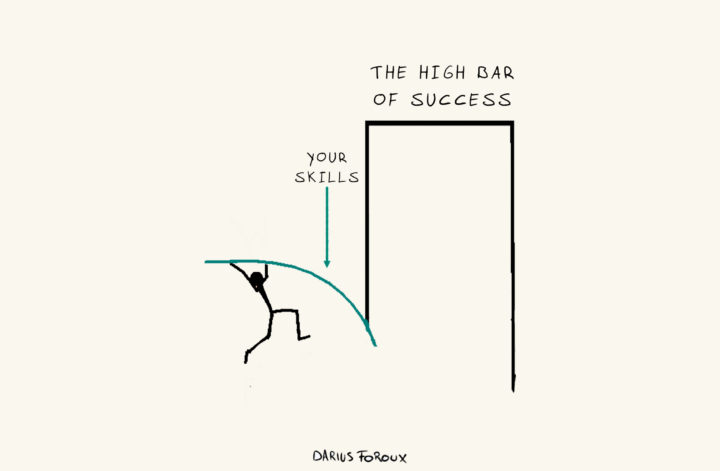I recently read an alarming statistic about the health of workers in The Netherlands. Compared to before the pandemic, 13% more people took sick leave due to mental reasons.1Source: NU.nl Stress and anxiety are major factors in our ability to live and work well.
From what I can see online, this trend is happening across the globe. And the most worrisome part is that people who go on sick leave for mental issues don’t come back to work that quickly.
It’s not like you get the flu, stay at home for a week, and then come back.
We must do everything we can to prevent burning out or getting so overwhelmed that we can’t work anymore. Not just for the money but for our own happiness.
We generally feel more alive and useful when we’re engaged at work. That’s a good way to go through life.
Let me give you 5 mental exercises that help you to tame stress and anxiety.
1. Use the “so what” technique
We all have those moments where things don’t go as planned, or a minor inconvenience throws us off course.
Whether it’s spilling coffee on your shirt or getting stuck in traffic, these small stressors can add up and take a toll on our mental health. That’s where the “so what” technique comes into play.
Instead of letting these minor hiccups ruin your day, shrug them off by saying “So what.” This simple yet powerful phrase reminds us that these fleeting moments won’t matter in the long run. Epictetus said it well:
”It’s not what happens to you, but how you react to it that matters.”
It’s about training your mind to focus on what’s important and letting go of the minor inconveniences that life throws at us.
2. Think about the end
Our daily lives are filled with tasks, deadlines, and responsibilities. We fret over presentations, meetings, and making mistakes at work.
But let’s put things into perspective. At the end of your life, you’re not going to think about the times you screwed up a presentation or missed a deadline.
Instead, you’ll likely reflect on the relationships you’ve built, the places you’ve seen, and the person you’ve become.
So let’s say you go through life worrying about small things and driving yourself nuts. Now you’re on your deathbed. And you’re given the chance to keep living.
Here’s what you should do as the philosopher-king Marcus Aurelius said:
“Think of yourself as dead. You have lived your life. Now take what’s left and live it properly.”
Living properly means not stressing about the things you don’t control.
3. Try the “View from Above” technique
In the busyness of our daily lives, it’s easy to get lost in the details and let minor problems overshadow our happiness.
Here’s where the Stoic exercise known as the “View from Above” technique can help.
This mental strategy encourages us to metaphorically rise above our problems, envisioning ourselves looking down on them from a bird’s eye view.
When we take a moment to step back and observe our situation from this broader perspective, our problems often appear less significant. They become small blips in the grand scheme of our lives, and this shift in perspective can be incredibly liberating.
As the ultrarunner and former Navy SEAL, David Goggins put it:
“I was the sum total of the obstacles I’d overcome.”
In other words, our value is not determined by the obstacles we face but by our aspirations and how we choose to overcome these challenges.
4. Use the “5 minute worry time” strategy
Worrying is a natural human response to uncertainty. But when we allow our worries to consume our thoughts at all hours of the day, they can quickly become overwhelming.
One effective strategy to manage this is by only giving yourself five minutes to worry and sulk over negative emotions. Call this your 5 minutes of worry time.
Worrying is a natural part of life. We all have things that cause us stress and anxiety, whether it’s work, relationships, or just the daily grind. And sometimes, it can feel overwhelming to try and push those worries away. But having a bit of time to allow ourselves to worry can also be helpful.
So during your 5 minutes of “worry time,” allow yourself to think about all the things that are causing you stress.
Give yourself permission to worry. By acknowledging our worries, we can better manage and control them. But once the time is up, move on to something else.
5. Adopt the Stoic practice of “Premeditatio Malorum”
Have you ever found yourself worrying about an event, only to find that the worry was worse than the event itself? You’re not alone.
This is where the Stoic exercise of premeditatio malorum comes in. It’s a Latin term for “premeditation of evils.”
It involves visualizing the worst-case scenario in any situation. While this might seem like a pessimistic approach, it’s actually a powerful tool to manage anxiety.
When you imagine the worst outcome, you’re mentally preparing yourself for it. It’s like having a dress rehearsal for a play. You go through all the motions, so when it’s showtime, you’re ready.
More often than not, you’ll find that the worst-case scenario is something you can actually handle. So you think, “Why am I worrying about this stuff?”
Your worries are rarely as bad as your imagination makes it out to be. Seneca said it best:
”We suffer more often in imagination than in reality.”
So, by confronting our fears head-on, we can reduce their power over us.
Remember, these exercises are not a cure-all for stress and anxiety. They are tools that, when used regularly, can help you manage your mental health more effectively.d




